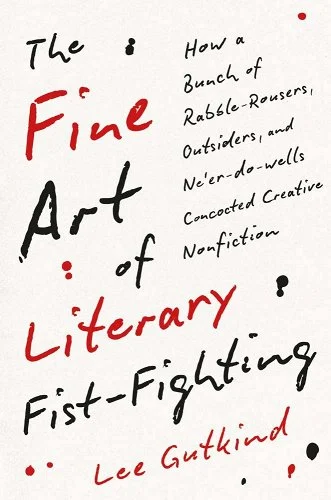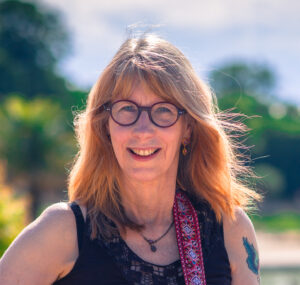Review by Christy Moore
 More than once in his book, The Fine Art of Literary Fist-Fighting: How a Bunch of Rabble-Rousers, Outsiders, and Ne’er-do-wells Concocted Creative Nonfiction, Lee Gutkind protests that he is not and never has been a scholar. His goal is to track creative nonfiction’s evolution from bastard child of journalism to a full-fledged literary genre; as a major advocate for the genre he’s in a good position to tell the tale. I’d argue, though, that a foundational strength of the book is in the scholarly work Gutkind does in the opening chapters which review the roots of, early practitioners of, and resistance to creative nonfiction.
More than once in his book, The Fine Art of Literary Fist-Fighting: How a Bunch of Rabble-Rousers, Outsiders, and Ne’er-do-wells Concocted Creative Nonfiction, Lee Gutkind protests that he is not and never has been a scholar. His goal is to track creative nonfiction’s evolution from bastard child of journalism to a full-fledged literary genre; as a major advocate for the genre he’s in a good position to tell the tale. I’d argue, though, that a foundational strength of the book is in the scholarly work Gutkind does in the opening chapters which review the roots of, early practitioners of, and resistance to creative nonfiction.
He begins in the 1960s with Tom Wolfe and Gay Talese. Creative nonfiction as it exists today grew from the innovative journalism that they practiced. New journalism, as Wolfe dubbed it, was marked by a rejection of the traditional formulaic structure and tone of journalism and the adoption of more engaging techniques: writing in scenes; developing characters; abandoning the pretense of objectivity; becoming, as the writer, a character in the narrative; and employing a style that is emotional, personal, and idiosyncratic, or even outrageous. From that mid-twentieth century starting point, Gutkind swings back to earlier nonfiction writers, such as Defoe, Dickens, London, and Hemingway.
That broad overview sets the stage for what follows as Gutkind begins peeling the onion to examine the contribution of marginalized writers to the changing shape of nonfiction as well as their struggles to do the work in the first place. In his survey of important women and nonwhite nonfiction writers, Gutkind telescopes in on writers like Nelly Bly, who got herself committed to an insane asylum (as they were called in her time) in 1872 so she could write about the inhumane treatment of the mentally ill; Ida B. Wells, who was born in slavery and later published eye-witness accounts of lynchings in the south; Zora Neale Hurston, a remarkable writer of fiction and nonfiction, who died in poverty; Alex Haley whose books, The Autobiography of Malcolm X and Roots, were groundbreaking; and Rachel Carson whose 1962 book about an impending environmental crisis, Silent Spring, has been linked to the passage of Clean Air Act and the creation of the Environmental Protection Agency. Carson is the lynchpin in Gutkind’s argument that many marginalized writers were driven by a desire to write stories that could bring about political and social change.
It’s in his analysis of the 1973 anthology The New Journalism, edited by Tom Wolfe and W.E. Johnson, that Gutkind strikes his most solid blow for women writers and writers of color who have been excluded by white, Harvard-educated men. Wolfe and Johnson only included two women (Joan Didion and Barbara Goldsmith) in their collection and no men or women of color. Though Gutkind recognizes that diversity was not on anyone’s mind in 1973, he makes a powerful indictment of Wolfe, pointing out glaring omissions. He calls attention to one omission in particular: James Baldwin. “I could see why Wolfe would not have included Baldwin in his anthology. Not because he was Black, but more so he was not part of Wolfe’s old boy network,” Gutkind writes. He goes on to posit another reason Baldwin was excluded. “[M]aybe “Notes of a Native Son” [was] just too damn good. It would show, alongside the many writers Wolfe included in that collection, what was missing in the new journalism.”
In the remaining three sections, which make up the bulk of the book, Gutkind recounts the resistance he encountered as a student and later as a writing professor to viewing nonfiction as a creative form much less literature. University creative writing programs were scarce when Gutkind began teaching; those that did exist and English departments in general only recognized three genres: fiction, poetry, and drama. For decades Gutkind fought for a fourth genre: creative nonfiction
Even after the genre began to gain traction, it was maligned. A 1997 article in Vanity Fair by James Wolcott sums up the objections. The article, “Me, Myself, and I,” opens with this invective: “The new, confessional school of writing known as “creative nonfiction” has spawned workshops, journals, manuals, college courses—and an avalanche of needy, self-parodic memoirs. Never have so many shared so much of so little.”
In 2013 I had the opportunity to interview the songwriter, Billy Joe Shaver. He told me that he was considered part of the Outlaw country music movement of the late 60s and early 70s along with Willie Nelson and Kris Kristofferson for one simple reason. It wasn’t because he drank and smoked pot and got into fist fights; it was because he wrote personal songs that were about his real-life experience told in his idiosyncratic east Texas vernacular. He was shunned by the Nashville establishment because he wrote confessional songs that were emotionally raw.
I was struck then and am struck now, having read Gutkind’s book, by the notion that confessional writing is subversive. But I notice that Gutkind portrays himself as a street fighter and an outsider and that Billy Joe Shaver portrayed himself as an outlaw. The similarity of perception in those two disparate writers makes me think that Gutkind has done more than trace a shift in academic thinking. I suspect he has documented one aspect of a cultural shift toward viewing the stories of outsiders, outcasts, and people without power as valuable, a subversive shift that threatens the primacy of those in power.
The denouement in Gutkind’s journey comes when he founds and publishes the academic journal Creative Nonfiction and finds overwhelming enthusiasm for the journal and the genre itself. At that point Gutkind and everyone who advocated for creative nonfiction as a genre have won. It’s a satisfying, hard-won knockout.
And the book itself is a good read. Gutkind is not just writing about creative nonfiction; he is writing a work of creative nonfiction, telling the story of an academic and literary struggle that has scenes and interesting characters, one of whom is Gutkind himself.
 Christy Moore is a songwriter, blogger, and essayist who teaches writing at the University of Texas. She has been published in The Disruptive Quarterly and is currently working on a memoir about her great grandfather who refused to fight for the Confederacy and was later hung for murder.
Christy Moore is a songwriter, blogger, and essayist who teaches writing at the University of Texas. She has been published in The Disruptive Quarterly and is currently working on a memoir about her great grandfather who refused to fight for the Confederacy and was later hung for murder.


